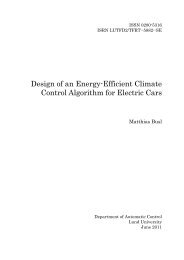reducing revenue loss due to disturbances in ... - Automatic Control
reducing revenue loss due to disturbances in ... - Automatic Control
reducing revenue loss due to disturbances in ... - Automatic Control
You also want an ePaper? Increase the reach of your titles
YUMPU automatically turns print PDFs into web optimized ePapers that Google loves.
Because of the reduction of the <strong>in</strong>direct <strong>revenue</strong> <strong>loss</strong>es<br />
caused by MP steam, cool<strong>in</strong>g fans 1-3 and feed water, the<br />
order<strong>in</strong>g is changed when <strong>in</strong>clud<strong>in</strong>g buffer tanks <strong>in</strong> the site<br />
model. Table 6 shows how much the <strong>revenue</strong> <strong>loss</strong>es caused<br />
by these utilities decrease when <strong>in</strong>ternal buffer tanks are utilized.<br />
In the table, the utilities are ordered accord<strong>in</strong>g <strong>to</strong> the<br />
reduction of the <strong>revenue</strong> <strong>loss</strong> <strong>in</strong> money.<br />
Table 6. Decrease of <strong>revenue</strong> <strong>loss</strong>es when <strong>in</strong>clud<strong>in</strong>g buffer<br />
tanks.<br />
Utility Decrease (%)<br />
Cool<strong>in</strong>g fan 1 54<br />
Cool<strong>in</strong>g fan 2 86<br />
Cool<strong>in</strong>g fan 3 80<br />
MP steam 7<br />
Feed water 4<br />
7. Conclusions and Future work<br />
The case study at Pers<strong>to</strong>rp presented <strong>in</strong> this paper gives order<strong>in</strong>g<br />
of utilities at the site accord<strong>in</strong>g <strong>to</strong> an estimate of the<br />
<strong>loss</strong> of <strong>revenue</strong> they cause, us<strong>in</strong>g an on/off model<strong>in</strong>g approach<br />
with buffer tanks between areas. It also illustrates the<br />
<strong>in</strong>fluence of buffer tanks at the site, by show<strong>in</strong>g how much<br />
the <strong>loss</strong> <strong>in</strong> <strong>revenue</strong> caused by <strong>disturbances</strong> <strong>in</strong> utilities can be<br />
reduced by <strong>in</strong>troduc<strong>in</strong>g buffer tanks between the areas.<br />
Strategies for <strong>reduc<strong>in</strong>g</strong> the <strong>revenue</strong> <strong>loss</strong> <strong>due</strong> <strong>to</strong> utility <strong>disturbances</strong><br />
are suggested for the Stenungsund site. It should<br />
be noted that only <strong>disturbances</strong> <strong>in</strong> utilities have been considered.<br />
This is only one piece of the entire picture, where<br />
also market conditions, cost of <strong>in</strong>ven<strong>to</strong>ries and other <strong>disturbances</strong><br />
must be taken <strong>in</strong><strong>to</strong> account. This case study shows<br />
which constra<strong>in</strong>ts <strong>disturbances</strong> <strong>in</strong> utilities place on buffer<br />
tank levels and product flow control. The aim of this study<br />
was not <strong>to</strong> achieve the optimal trade-off between utility disturbance<br />
management and <strong>in</strong>ven<strong>to</strong>ry costs.<br />
The on/off production model<strong>in</strong>g approach <strong>in</strong>clud<strong>in</strong>g<br />
buffer tanks should give more accurate estimates of the<br />
<strong>loss</strong>es that are caused by utilities at a site than the on/off<br />
model without buffer tanks. However, areas are still modeled<br />
as on or off, and thus the site model does not adequately<br />
reflect the actual production. To catch more of the variability,<br />
the site should be modeled us<strong>in</strong>g a cont<strong>in</strong>uous production<br />
model. Cont<strong>in</strong>uous production model<strong>in</strong>g of a site is<br />
currently be<strong>in</strong>g <strong>in</strong>vestigated, and will also be applied <strong>to</strong> Pers<strong>to</strong>rp’s<br />
site at Stenungsund. With cont<strong>in</strong>uous production,<br />
more elaborate reactive disturbance management strategies<br />
may be obta<strong>in</strong>ed, that gives real-time advise <strong>to</strong> opera<strong>to</strong>rs on<br />
how <strong>to</strong> control the product flow at the occurrence of a disturbance.<br />
Acknowledgments<br />
This research was performed with<strong>in</strong> the framework of the<br />
Process Industrial Centre at Lund University (PIC-LU),<br />
which is supported by the Swedish Foundation for Strategic<br />
Research (SSF).<br />
References<br />
Bakhrankova, K. (2010). Decision support system for cont<strong>in</strong>uous<br />
production. Industrial Management & Data Systems, 110(4),<br />
591–610.<br />
Bauer, M., Cox, J.W., Caveness, M.H., Downs, J.J., and Thornhill,<br />
N.F. (2007). Nearest neighbors methods for root cause analysis<br />
of plantwide <strong>disturbances</strong>. Ind. Eng. Chem. Res,46,5977–5984.<br />
Faanes, A. and Skogestad, S. (2003). Buffer tank design for acceptable<br />
control performance. Ind. Eng. Chem. Res., 42(10),<br />
2198–2208.<br />
Hopp, W.J., Pati, N., and Jones, P.C. (1989). Optimal <strong>in</strong>ven<strong>to</strong>ry<br />
control <strong>in</strong> a production flow system with failures. International<br />
Journal of Production Research, 27(8),1367–1384.<br />
Kano, M. and Nakagawa, Y. (2008). Data-based process moni<strong>to</strong>r<strong>in</strong>g,<br />
process control, and quality improvement: Recent developments<br />
and applications <strong>in</strong> steel <strong>in</strong>dustry. Computers & Chemical<br />
Eng<strong>in</strong>eer<strong>in</strong>g, 32(1-2),12–24.<br />
L<strong>in</strong>dholm, A. (2011). A method for improv<strong>in</strong>g plant availability<br />
with respect <strong>to</strong> utilities us<strong>in</strong>g buffer tanks. In proceed<strong>in</strong>gs of the<br />
IASTED International Conference on Model<strong>in</strong>g, Identification<br />
and <strong>Control</strong> (MIC 2011), Innsbruck, Austria,378–383.<br />
L<strong>in</strong>dholm, A., Carlsson, H., and Johnsson, C. (2011a). Estimation<br />
of <strong>revenue</strong> <strong>loss</strong> <strong>due</strong> <strong>to</strong> <strong>disturbances</strong> on utilities <strong>in</strong> the process<br />
<strong>in</strong>dustry. In proceed<strong>in</strong>gs of the 22 nd Annual Conference of<br />
the Production and Operations Management Society (POMS),<br />
Reno, NV, USA.<br />
L<strong>in</strong>dholm, A., Carlsson, H., and Johnsson, C. (2011b). A general<br />
method for handl<strong>in</strong>g <strong>disturbances</strong> on utilities <strong>in</strong> the process <strong>in</strong>dustry.<br />
In proceed<strong>in</strong>gs of the 18 th World Congress of the International<br />
Federation of Au<strong>to</strong>matic <strong>Control</strong> (IFAC), Milano, Italy,<br />
2761–2766.<br />
Maia, L.O.A., de Carvalho, L.A.V., and Qassim, R.Y. (1995). Synthesis<br />
of utility systems by simulated anneal<strong>in</strong>g. Computers &<br />
Chemical Eng<strong>in</strong>eer<strong>in</strong>g, 19(4),481–488.<br />
Maia, L.O.A. and Qassim, R.Y. (1997). Synthesis of utility systems<br />
with variable demands us<strong>in</strong>g simulated anneal<strong>in</strong>g. Computers &<br />
Chemical Eng<strong>in</strong>eer<strong>in</strong>g, 21(9),947–950.<br />
Newhart, D.D., S<strong>to</strong>tt Jr., K.L., and Vasko, F.J. (1993). Consolidat<strong>in</strong>g<br />
product sizes <strong>to</strong> m<strong>in</strong>imize <strong>in</strong>ven<strong>to</strong>ry levels for a multi-stage<br />
production and distribution system. The Journal of the Operational<br />
Research Society, 44(7),637–644.<br />
Niebert, P. and Yov<strong>in</strong>e, S. (1999). Comput<strong>in</strong>g optimal operation<br />
schemes for multi batch operation of chemical plants. VHS deliverable.<br />
Draft.<br />
Papoulias, S.A. and Grossmann, I.E. (1983). A structural optimization<br />
approach <strong>in</strong> process synthesis–ı : Utility systems. Computers<br />
& Chemical Eng<strong>in</strong>eer<strong>in</strong>g, 7(6),695–706.<br />
Q<strong>in</strong>, S. (1998). <strong>Control</strong> performance moni<strong>to</strong>r<strong>in</strong>g - a review and<br />
assessment. Computers & Chemical Eng<strong>in</strong>eer<strong>in</strong>g, 23,173–186.<br />
Silver, E.A., Pyke, D.F., and Peterson, R. (1998). Inven<strong>to</strong>ry Management<br />
and Production Plann<strong>in</strong>g and Schedul<strong>in</strong>g. Wiley,New<br />
York.<br />
Thornhill, N.F., Xia, C., Howell, J., Cox, J., and Paulonis, M.<br />
(2002). Analysis of plant-wide <strong>disturbances</strong> through data-driven<br />
techniques and process understand<strong>in</strong>g. In proceed<strong>in</strong>gs of the<br />
15 th IFAC World Congress, Barcelona.














